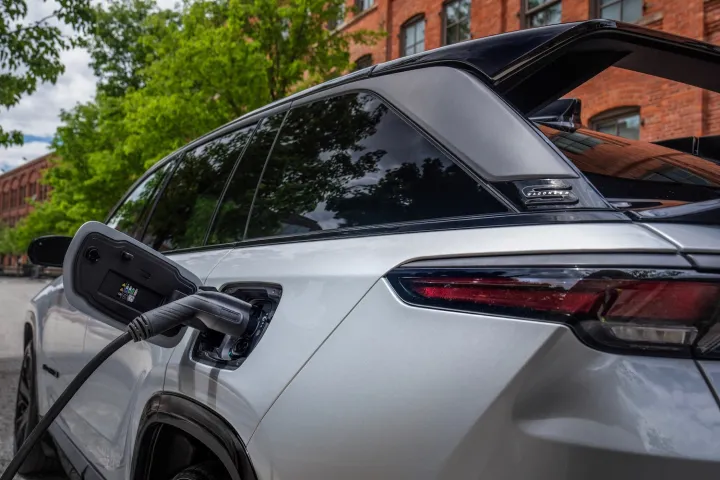
After getting things rolling with plug-in hybrids, Jeeps’ electrification plans are picking up speed. Scheduled to reach dealerships this fall, the 2024 Jeep Wagoneer S is the brand’s first EV for North America.
The Wagoneer name is right up there with Wrangler and Grand Cherokee in Jeep lore. The original Jeep Wagoneer was one of the first truly civilized SUVs and became the namesake for a modern sub-brand encompassing the Wagoneer and Grand Wagoneer, two leviathan gas guzzlers that went on sale as 2022 models. The Wagoneer S shares little with these SUVs besides a name.
Jeep announced the Wagoneer S alongside the more traditional-looking Recon, but opted to launch the Wagoneer S first because it makes better business sense, Jeep CEO Antonio Filosa told Digital Trends. It’s the right size vehicle for a lot of markets outside the U.S., will be the first Wagoneer sold abroad, and requires fewer new arrangements with suppliers, Filosa said, adding that this is an unexpected move for Jeep. This sleeker, more luxurious model is more of a departure from the brand’s norms.

In contrast to the relentlessly square design of gasoline Wagoneer models, the Wagoneer S has a streamlined shape much like the controversial Jeep Cherokee that was recently discontinued. The goal was to make the Wagoneer S as aerodynamic as possible to help maximize range, without making it look like a “lozenge,” Ralph Gilles, design boss of Jeep parent Stellantis, said at the vehicle’s reveal. Designers also included a large rear wing straight out of a “Fast and Furious” movie to help with that. The trademark seven-slot grille also lights up, emphasizing that, regardless of what the rest of the styling might say, this is a Jeep.
The Wagoneer S shares the STLA Large platform with the Dodge Charger Daytona from Jeep’s fellow Stellantis brand. Jeep claims its engineers tailored the platform’s dimensions to the Wagoneer S, though. The result is an SUV that’s as wide and tall as a Tesla Model Y, but substantially longer. That doesn’t translate to an advantage in headroom, legroom, or cargo space, however. The Model Y also has a larger frunk.
The first batch of vehicles to reach dealerships will be Launch Edition models with a standard dual-motor powertrain producing 600 horsepower and 617 pound-feet of torque. Jeep claims this will propel the Wagoneer S from zero to 60 mph in 3.4 seconds, making it the brand’s quickest production model to date. It’s also 0.1 second quicker than a Model Y Performance but, with a base price of $71,995, the Wagoneer S Launch Edition is pricier.

Because this is a Jeep, the Wagoneer S also offers some degree of off-road capability A version of the Selec-Terrain system from gasoline and plug-in hybrid Jeep models includes Auto, Sport, Eco, Snow, and Sand drive modes, but the 6.4 inches of ground clearance listed on the spec sheet is less than you get with a Subaru Crosstrek. Jeep showed a concept version dubbed the Trailhawk with lifted suspension and more off-road-worthy tires at the Wagoneer S reveal, but it’s not confirmed for production.
A 100.5-kilowatt-hour battery pack will provide more than 300 miles of range per charge, Jeep estimates. The Wagoneer S uses a 400-volt electrical system, rather than 800V, but Jeep still expects a 20% to 80% DC fast charge to take just 23 minutes. Launch Edition models also come with a 48-amp Level 2 AC home charger that can complete a 5% to 80% charge in an estimated 6.8 hours.
The standard infotainment interface includes a 12.3-inch central touchscreen and 12.3-inch digital instrument cluster, plus a 10.25-inch touchscreen for the front passenger and a 10-inch head-up display. Stellantis’ Uconnect 5 infotainment system is compatible with wireless Apple CarPlay and Android Auto, as well as over-the-air (OTA) updates. A 19-speaker McIntosh audio system is standard on Launch Edition models as well.
The high level of standard equipment is indicative of this EV’s positioning as a Wagoneer rather than an ordinary Jeep, which implies a higher level of luxury. That’s also reflected in a cabin that features high-end materials like ceramic-coated aluminum trim. However, Jeep chose synthetic leather upholstery as a more sustainable option, along with a headliner and carpets made from recycled material. Designers also avoided use of wood trim to give the cabin a more modern feel.
The Wagoneer name is Jeep-speak for “upscale,” but in its launch configuration, the Wagoneer S may have difficulty competing with the Model Y and other similar-sized electric SUVs priced below it. Jeep has a more distinctive EV coming in the form of the Recon, which takes its inspiration from the brand’s signature Wrangler and perhaps would have been a better model to lead with.












